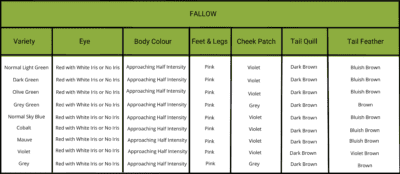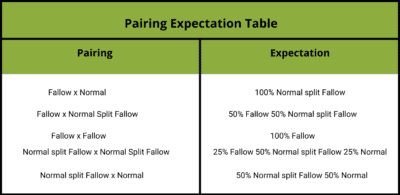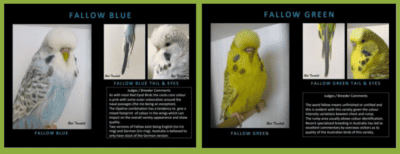
Fallow Budgerigar
The Fallow budgerigar, as many other mutations had done, appeared about the same time in Australia and Germany, but it is recorded that the first Fallow mutation evolved and was established in the aviaries of Mr O’Brien, of Newtown, Sydney, during the early part of 1930. In parallel in Europe, the first Fallow was reported in Germany around 1934. Another variation of the Fallow appeared in Scotland, which at the time was thought to be the same as the Australian mutation, but later comparison showed minor differences.
The key difference between the three varieties visually is the colour of the eye. Whereas the English Fallow has a red eye and no iris ring, the Australian mutation has an extremely deep coloured red eye with an iris ring, while the Scottish Fallow has a pink iris ring. In other respects, the English, Scottish and German Fallows are very similar. All resemble Cinnamons, but differ in having a much weaker body colour. The Standard of Perfection calls for half intensity.

Image Courtesy of Rod Turnbull and the ANBC
The word “fallow” originated in Switzerland and meant untilled or undeveloped. The intention was never to describe the color of the bird, but rather that the pigment was untilled and undeveloped.
Identification of the Fallow Budgerigar
The Standard calls for the exhibition Fallow budgerigar body colour to approach 50% of the intensity of the normal equivalent. It will carry intensified colour over the rump and back. The Fallow has a deep and wide mask that extends beyond two large cheek patches. Six evenly spaced, large, round dark brown throat spots ornament the mask. In addition, the base of the cheek patches partially covers the two outer spots. Markings on the cheeks, back of head, neck and wings are dark brown, clearly defined and symmetrical on the appropriate ground colour and free from any intrusion of body colour or ‘bloom’.
The Fallow budgerigar has a red eye and The Standard accepts it whether or not it has a white iris ring. The legs and the feet are pink in color. In terms of gender, the cock has a blue flesh coloured cere, while the hen has a brown cere.
Below is a summary of the colors of the Fallow budgerigar’s cheek patch, tail quill, and tail feathers.
Summary of Features

Fallow Budgerigar Pairing Expectations
The Fallow budgerigar is a recessive variety. Therefore, the expected pairing outcomes would be as follows:

Click here to view pairing expectation in full
Fanciers generally do not prefer the final two fallow budgerigar pairing combinations, as they cannot identify the splits without test mating. However, there is a trick with fallows, depending on the colour of the parents, as the Fallow gene appears closely placed to that of the Grey factor gene (Grey Green in the Green series).

